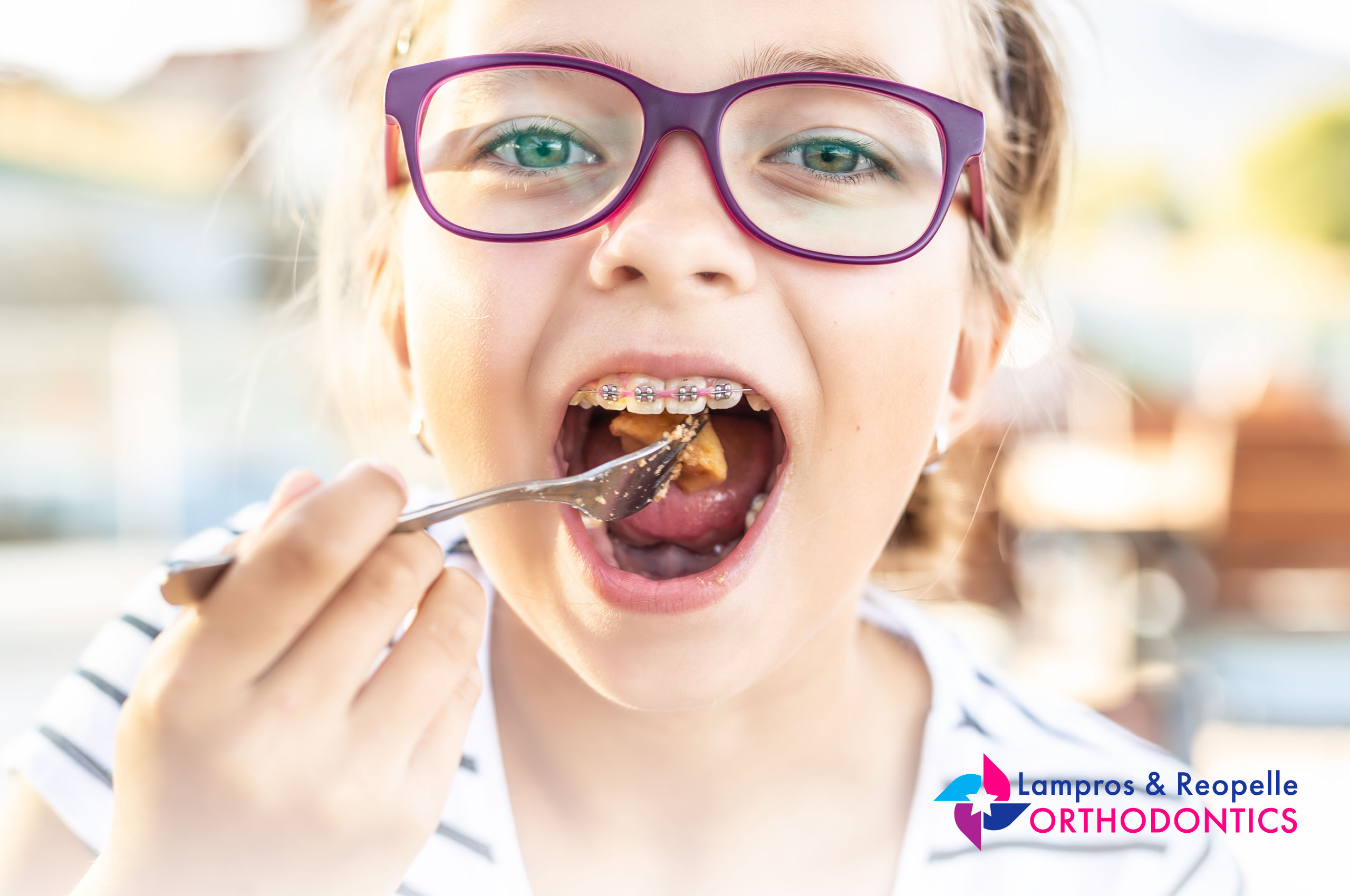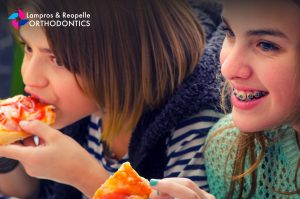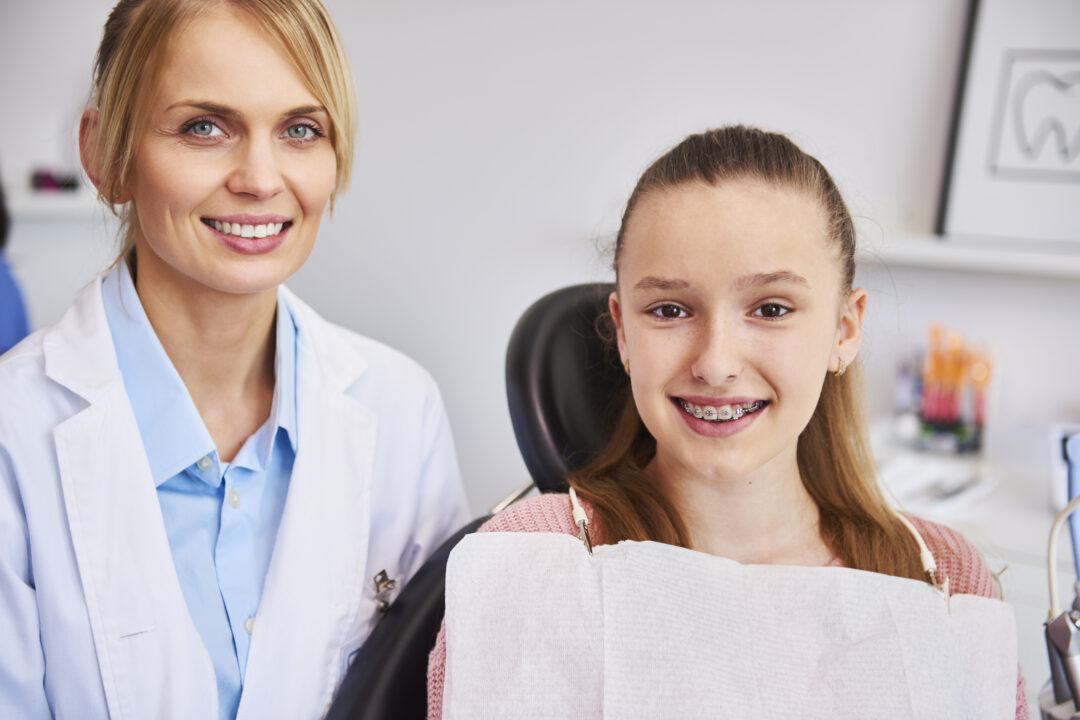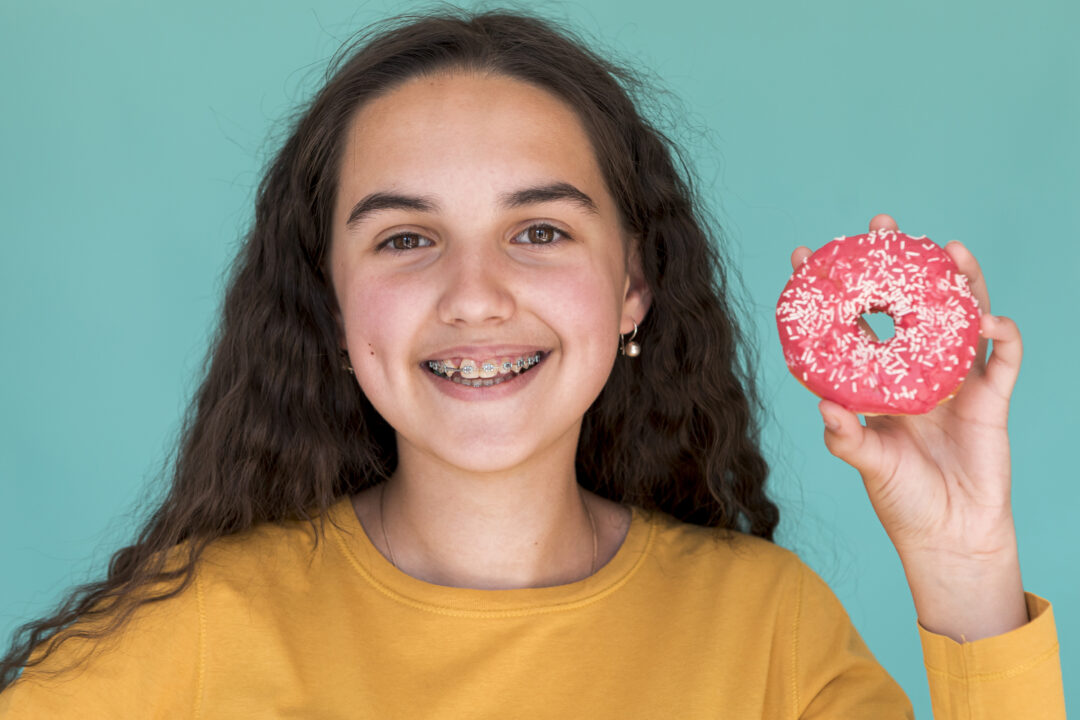What Can I Eat With Braces?

Food. Who doesn’t like eating? Alone, with friends or family, during a date, as a quick bite in between classes or work meetings. You may have noticed we love food, especially when they give us our favorite foods. But how do people with braces eat their food? Have you wondered what you can and can’t eat with braces?
A successful orthodontic treatment implies making many adjustments to our lives during those 6 to 18 months. One of the most important adjustments you’ll have to make includes changing your dietary habits. We want to make sure our patients know what to expect before embarking on this journey; similarly, we want to provide you with some solutions to these issues to make the journey a lot easier.
Keep in mind most of these limitations are for patients wearing braces. When you wear aligners, you won’t have as many limitations, which is one of the various advantages you get when using Invisalign. So, without any further delay, let’s review what you can and shouldn’t eat while you wear your braces.
What Can I Eat After I Get My Braces?
Ok, so first things first. Let’s review all the options available to patients who are just beginning their orthodontic treatment. After all, many patients report discomfort and low levels of pain when their orthodontist first bonds and adjusts brackets to their teeth.
During that time, patients usually report tenderness, heightened sensitivity to extreme hot or cold foods and beverages, or soreness. Usually, these symptoms are easily manageable with over-the-counter pain medication, but if the problems don’t subside within the first week or two, get in touch with your orthodontist.
Parenthesis aside, because patients are more vulnerable at the beginning of their treatment, it might help to know what are some safe to eat foods with your braces. You’ll notice there are plenty of tasty options for you to include in your meals.
- Mashed potatoes
- Yogurt
- Soups
- Scrambled eggs
- Oatmeal
- Grains
- Seafood
- Soft fruits
- Soft cheeses
- Cooked or soft vegetables
- Moist desserts
- Pasta
See? Anything that’s soft and easy to chew, but also delicious, will be your ally during those first weeks. Any feeling of discomfort and sensitivity should subside within a couple of days as your mouth becomes used to the additional pressure over your teeth. You can then transition towards other foods.
What Foods To Avoid the First Days of Braces?
We just gave you a shortlist of foods you can rely on for the first couple of days, but there are also some options you should stay away from those first few weeks. You might eat them later, as they’re not necessarily things that might damage your braces and cause an orthodontic emergency. Still, they may increase the discomfort and lengthen any initial adjustment period the patient needs.
Please avoid the following:
- Ice cream
- Thick rolls or bread
- Thicker cuts of meats
- Spicy foods
- Citrus foods.
Please, try to keep the patient away from anything that’s too sticky, chewy, or acidic, as they can all increase the levels of discomfort.
Trust us. These restrictions may seem a bit hard to handle, but it will be both worth it and not as hard as it seems.
The Foods You Should Never Eat With Braces
We usually say that adults are better at compliance with our instructions, but the reality is that anyone may fail to obey all directions, especially when it comes to rejecting food that you used to enjoy in social settings.
Please, do your best to stay away from the foods we’ll be listing below, as they can easily damage your braces and delay your treatment considerably. Furthermore, some of these foods can cause situations that could harm you.
Parents who wish to help their kids complete their orthodontic treatment will have to keep an eye out for some of these foods and prevent their consumption to avoid orthodontic emergencies that cause unwanted pain, discomfort, and potential trauma.
- Popcorn
- Nuts
- Ice cubes
- Chewing gum
- Hard candy
- Chewy candy
- Hard crackers
- Pretzels
- Chips
Some of these you may have seen coming, others are a bit less obvious as apples and other hard fruits. Many of these items are hard enough that a piece can get in between the patient’s tooth and bracket and peel away, separating the bracket.
Usually, the bonding agent is very strong and prevents direct force to pull away and dislodge any bonded pieces. But try as we may, we cannot defy the laws of physics, and the brackets may be peeled away with relative ease with a little leverage action from any hard piece that fits in the right position.
Such a thing happens by design. After all, do you imagine how traumatic it would be if the only way to remove brackets was to yank away at each piece?
No thanks.
Can You Eat Pancakes with Braces?
Fortunately, yes. You or your child can safely have pancakes when you’re wearing braces to have a straight smile. As with most other foods, you’ll be better off when you make sure your oral hygiene habits match your choice of meals. Pancakes by themselves are not harmful to your teeth or brackets, but pairing them with too much syrup, jam, or other toppings can make them a danger to your oral health. Always brush your teeth and clean your braces after eating pancakes!

Sticky pieces of pancake and syrup might get caught around the archwire that connects all your brackets. If you leave them there, those leftovers will promote the growth of harmful bacteria and weaken your teeth. Make sure you don’t overindulge in pancakes, but there’s no harm in occasionally having them for your Sunday brunch.
Can I Eat Anything With My Invisalign?
So, now you have a better understanding of the various limitations braces users have to deal with. However, the whole idea behind wearing Invisalign is that you can enjoy all the benefits of having removable aligner trays.
Keep in mind most of these limitations are for patients wearing braces. When you wear aligners, you won’t have as many limitations, which is one of the various advantages you get when using Invisalign.
Make sure you ask your orthodontist about what will work best in your case. Most patients will prefer to take off their aligner trays before they start eating their meals. Others, however, might try leaving the trays on and chewing to better seed them and promote faster adjustments.
Still, you should mind some of the beverages you drink while you wear your retainers. Some drinks, such as coffee, black tea, and red wine, are all liquids that can potentially stain your aligners. The whole idea of wearing clear aligners is that you use an appliance that escapes any prying eyes. It will be easier to notice them in your mouth if you stain them.
Keep some of these recommendations in mind, and you’ll get to continue enjoying your favorite foods and drinks with no harm coming to your orthodontic appliance.
Food for Thought and the Importance of Hygiene
There’s one more reason why we make all these recommendations. Oral care. When a patient wears braces, they are at a disadvantage when it comes to fighting against harmful bacteria. Sure, it’s not impossible. If it were incredibly difficult to maintain good oral hygiene, we would never even recommend these treatments, but patients will certainly be challenged to maintain a good oral hygiene routine.
Cleaning around brackets and in between teeth that have wires and metal pieces attached to them is not easy. Read along with our articles about thoroughly cleaning your teeth with braces here.
But keeping your mouth clean is not just about how good you are at brushing or the tools you use to supplement your dental care routine; it’s also about what you choose to eat. Sticky and chewy foods can easily leave leftover food particles stuck in the nooks and crannies of your teeth and brackets.
Your choice of foods and beverages will greatly impact your dental health.
Consider Using an Interdental Brush
There are several tools you can use to strengthen your oral hygiene routine. One such tool is the interdental brush. These little brushes help reach in between your teeth and can also help remove any food debris caught between your braces’ brackets and wires.
You can still get excellent results using a soft-bristled toothbrush at home, but considering you can buy interdental brushes in packages, why not give them a try? It will be far easier to keep your mouth clean when you use an interdental brush and rinse vigorously with water after your main toothbrushing session.
The Best Orthodontist Roanoke Can Trust
Experienced orthodontists like Dr. Ann Reopelle will always recommend what’s best for their patients. Make sure you set an appointment with your team to review how to continue with your orthodontic treatment.
Let’s advance together towards the best version of your smile.



